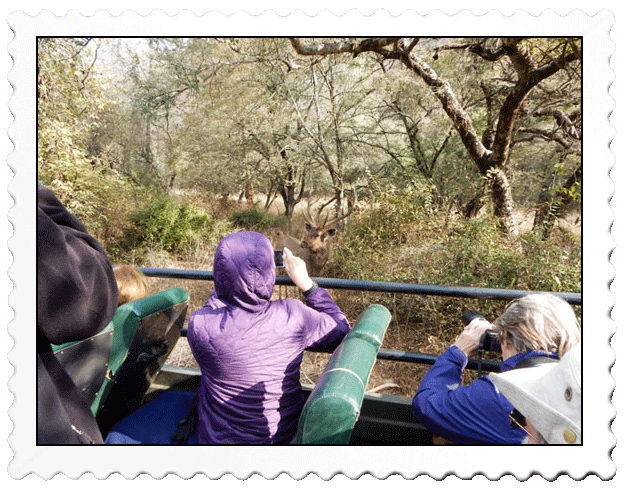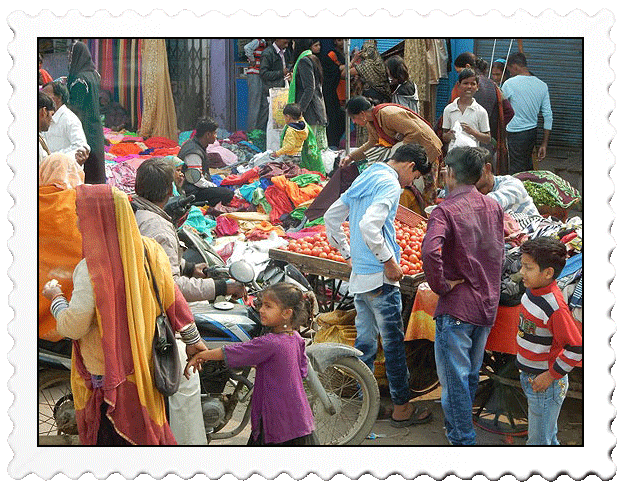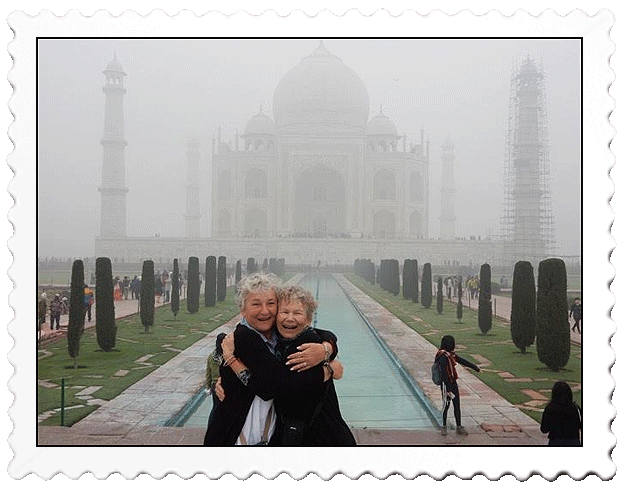By David Gjestson

India is probably one of the most exotic and culturally diverse countries you could visit. It is home to 32 UNESCO World Heritage sites, the crossroads of six major religions, exposure to 22 spoken languages, and a mass of people, animals, sights, smells and tastes bound to enthrall.
Comprised of 1.25 billion people, India is the most populous democracy in the world. They received their independence from England in 1947 and
formed a federal constitutional republic governed by a parliamentary system representing 29 states and seven union territories. It is a nuclear weapons state and contains the third largest standing military in the world.
Poverty is prevalent but has dropped dramatically from 60% of the population in 1981 to less than 25% today.
I have a 16-day camping trip coming up this fall, so it's only fair that my wife Laura (who is in the hotel stage of her life) gets to choose her own travel target, right? She chose 16-days in northern India, so a deal was made!
Once again Laura chose our favorite travel group, Overseas Adventure Travel (OAT) because of their first class guide service featuring small group travel (16 or less) and its educational focus. Her traveling companion was Jayma Newland from San Luis Obispo, a friend we met on a 2004 trip to Morocco who has been on several adventures with us since that time.
Travel from the United States to India is what most would call 'arduous.' From the west coast, Jayma and Laura first endured a 16-hour jaunt to Dubai, hoping that they'd enjoy seeing that incredible place and rest overnight before another four-hour flight to Delhi located in northwest India.
The quick cab tour they took through a spotless but empty city was impressive but jet lagged brains only afforded them a restless nights sleep.
This late January tour would start in Delhi and include the 'Golden Triangle' of Delhi, Agra and Jaipur. Meeting their guide while still travel-foggy along with 14 other travelers, the group spent three full days exploring Delhi. Highlights included visiting Raj Ghat, a beautifully serene monument on the site containing the cremated remains of Mahatma Gandhi, Jama Masjid, the largest mosque in India, and enjoying a rickshaw ride through the crowded lanes of a local bazaar.


Reasonably recovered by their fifth day on the road, the group boarded a small plane that would take them a few hours south to Jaipur, called the 'Pink City' because of the reflective color of its sandstone buildings. By now, adjusting to India food and its spicy flavors was a bit more palatable to most! Tour highlights included a unique Palace of the Winds that was really a facade of 956 honey-combed windows used by palace ladies to look at the outside world without being seen, and a 16th century fort-palace.
On the road again, this time absorbing a six-hour bus ride to Nagaur on bumpy roads puts old bones and weak bladders to the supreme test. Some in the group had already gotten ill, very normal happening when touring when travelers are subject to many people, unsanitary conditions, and strange food.

OAT busses are always modern and comfortable
Speaking of food, Indian food does take some adjustment of the palate, often curry laced and spicy. Rice, pearl millet, whole-wheat flour, lentils, and beans are a staple along with a variety of vegetables prepared in a hundred different ways. Meat is mostly chicken with mutton (goat) sometimes used. Beef and pork are never used as cows are religiously protected, and pigs survive wandering the streets consuming feces and garbage.
The six-hour bus ride ended at a camp in Nagaur, the site of a huge camel and cattle trade fair. Lodging was in rather luxurious tents complete with beds, furniture and bathrooms. The next two days were filled with camels rides, marketplace meanderings, folk dancing, animal watching, eating, and relaxing.

Tents at Nagaur conveniently adjoined the fair grounds

Jayma thought the camel ride was a hoot
Back on the bus, the group returned to their hotel in Jaipur for some rest time followed by sightseeing, museum touring, and a visit to a fabric-printing center to learn about the textiles made in this area. After a restful night, the bus took them overland to the Ranthambore National Park, one of eleven sites chosen for Project Tiger, India's national tiger conservation program.

Ranthambore National Park
The park consisted of more than one hundred square miles of deciduous forest and several large lakes, formerly a hunting preserve of the maharajas. Touring in open 4 x 4s the next two days, the group enjoyed seeing sambar, nilgai, chinkara, chital, and the always entertaining Langur monkey. Crested eagles, painted storks and more than 450 bird species provided many treats along the way with crocodiles and several species of deer added to the observatory mix.

The group toured Ranthambore National Park for two days seeking the elusive Indian tiger

One of several species of deer on the preserve

Langur monkeys
A highlight was a tense, crepuscular time in a cruising truck bed hoping to see one of the 26 tigers on the preserve. Every rustle of vegetation jolted nerves and increased pulses over two sessions of three hours each, but no luck! No tiger sightings. However, seeing a wide variety of wildlife helped overcome the group's no-tiger disappointment
Moving on, the group was bussed to a local village to visit students at a primary school, a common feature of OAT tours. The village itself was sponsored by OAT, meaning the organization spends a portion of touring revenues in the foreign countries where OAT is active. In this village, buildings, the school, teaching materials, and toilets were funded.
The toilets, rare in rural India, were called 'squat toilets' because they only consisted of an outhouse-looking building containing flooring with a hole in it requiring one to squat to do your business. There were no such toilets in rural India. People just defecated anywhere. In the cities and at airports, modern western toilets were available for tourists but separate 'Indian toilets' were provided because most of the populous didn't know how to use sitting toilets!

Bargaining in the market is always fun


After visiting the school, a cooperative of women who produced handicrafts, and visiting a family for tea and to hear about their way of life, the group returned to their hotel for the night. After a good night's rest, they were bussed to a train station for three-hour train ride to Agra in time for lunch and an afternoon of leisure on their own.
It was now day 14 of the tour, and it would be a highlight, visiting the Taj Mahal. This edifice is a UNESCO World Heritage site and became a
New 7 Wonders of the World (see Google for explanation) in 2000-2007.

The Taj Mahal is an ivory-white marble mausoleum on the south bank of the Yamuna River located on 42 acres adjoining the village of Agra. It was constructed between 1631 and 1653 to enshrine Queen Mumtaz Mahal, and took 20,000 workers to complete. The semi-translucent white marble is inlaid with thousands of semi-precious stones in beautiful patterns in a building comprised of four identical facades.

While still somewhat numb from absorbing the history and beauty of the Taj Mahal, the group were bussed to a nearby Agra Fort. It was a huge, sprawling fortress that was the seat of power for four generations of Mughl emperors who ruled all of northern India from early in the 16th century until the consolidation of the British colonial rule in the early 1800s.
Tourists are warned to protect hats, purses and flowers at Agra Fort as monkeys were very fast thieves!
Another two-hour train ride followed by a six-hour bus ride grinder got the group to Khajurado to view ninth and tenth century group of temples (another UNESCO World Heritage Site). Erotic stone carvings viewed the following day woke up any spirits that might have been lagging due to the strenuous travel challenges.


The erotic stone carvings proved to be a very popular tourist stop


The group then boarded a small plane that would take them on a 40-minute flight to Varanasi, one of the oldest cities in the world (written history dating back more than 4,000 years). Here, you could feel the spiritual vibrations of thousands of pilgrims emanating from hundreds of temples alongside the sacred River Ganges.

Pilgrims gather to pray by the river

River view of a busy shore as worshippers and merchants mix along the River Ganges


After exposure to marvelous scenes of devotees performing daily religious rites, museum tours, Buddha sculptures, the group ended the tour with a morning of yoga and meditation class before boarding their plane for a four-hour flight to Dehli.
A restful overnight was needed to face the grueling trip home! Another plane for the four-hour flight to Dubai followed by a 16-hour flight to San Francisco (sleepless thanks to the four screaming babies on their flight!).



























